Themed collection Insights into 2D Materials

Insights into 2D materials
This themed collection includes a collection of articles providing new insights into 2D materials.

Phys. Chem. Chem. Phys., 2022,24, 16940-16941
https://doi.org/10.1039/D2CP90105F
Recent trends in covalent functionalization of 2D materials
Covalent functionalization of the surface is crucial in 2D materials because of their atomic thinness, large surface-to-volume ratio, and uniform surface chemical potential.

Phys. Chem. Chem. Phys., 2022,24, 10684-10711
https://doi.org/10.1039/D1CP04831G
Polarized Raman spectroscopy in low-symmetry 2D materials: angle-resolved experiments and complex number tensor elements
Schematic of the experimental set-up to collect the angle-resolved polarized Raman spectra unveiling the optically anisotropic properties in 2D materials.
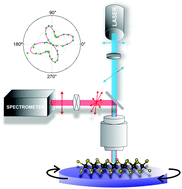
Phys. Chem. Chem. Phys., 2021,23, 27103-27123
https://doi.org/10.1039/D1CP03626B
Studying 2D materials with advanced Raman spectroscopy: CARS, SRS and TERS
Perspectives on advancing our understanding of two-dimensional materials using coherent anti-Stokes (CARS), stimulated (SRS) and tip-enhanced (TERS) Raman spectroscopy techniques.
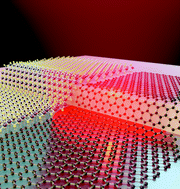
Phys. Chem. Chem. Phys., 2021,23, 23428-23444
https://doi.org/10.1039/D1CP03240B
2D ferroelectric devices: working principles and research progress
Due to their unique reversible polarization, 2D ferroelectrics are promising for nanodevice applications in ferroelectric field effect transistors, diodes and tunnel junctions.
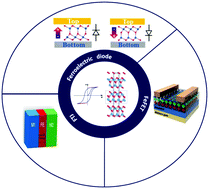
Phys. Chem. Chem. Phys., 2021,23, 21376-21384
https://doi.org/10.1039/D1CP02788C
A review on two-dimensional materials for chemiresistive- and FET-type gas sensors
The recent development of 2D material-based chemiresistive- and FET-type gas sensors as well as their future directions are comprehensively presented.

Phys. Chem. Chem. Phys., 2021,23, 15420-15439
https://doi.org/10.1039/D1CP01890F
Negative valley polarization in doped monolayer MoSe2
The dominant circular polarization of luminescence emission from monolayer MoSe2 in a magnetic field is effectively tuned by charge doping, allowing the valley polarization of exciton polarons to reach negative values.

Phys. Chem. Chem. Phys., 2022,24, 191-196
https://doi.org/10.1039/D1CP03490A
Synthesis of 2D semiconducting single crystalline Bi2S3 for high performance electronics
Single crystalline Bi2S3 flakes have been synthesized using H2S gas as a precursor, and their electronic devices show high mobility due to the superior crystal quality.

Phys. Chem. Chem. Phys., 2021,23, 26806-26812
https://doi.org/10.1039/D1CP03815J
Asymmetric carrier transport and weak localization in few layer graphene grown directly on a dielectric substrate
Temperature dependent electrical/magneto-transport measurements on few layer graphene grown directly onto dielectric substrates reveal weak localization, charge carrier asymmetry and phonon limited carrier mobility.
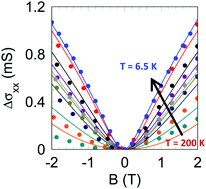
Phys. Chem. Chem. Phys., 2021,23, 25284-25290
https://doi.org/10.1039/D1CP03225A
Single sheets of graphene for fabrication of fibers with enhanced mechanical properties
This paper reports the fabrication and mechanical properties of macroscale graphene fibers (diameters of 10 to 100 μm with lengths upwards of 2 cm) prepared from a single sheet of single-layer graphene grown via chemical vapor deposition (CVD).
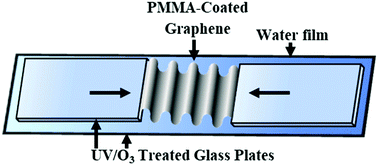
Phys. Chem. Chem. Phys., 2021,23, 23124-23129
https://doi.org/10.1039/D1CP03238K
A graphene–Mo2C heterostructure for a highly responsive broadband photodetector
A photodetector based on a graphene–Mo2C heterostructure delivers very high responsivities from visible to infrared telecommunication wavelengths.
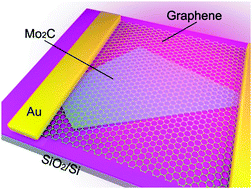
Phys. Chem. Chem. Phys., 2021,23, 23024-23031
https://doi.org/10.1039/D1CP03536C
Exploring the emerging of electronic and magnetic properties with adatom adsorption on a novel semiconductor monolayer: N2P6
The effect of adsorbed adatoms on the structural stability and electronic properties of novel semiconductor monolayer N2P6 have been systematically studied via first-principles simulation methods.
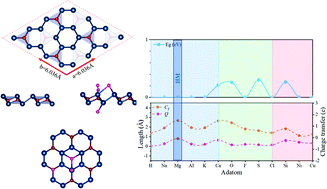
Phys. Chem. Chem. Phys., 2021,23, 22045-22056
https://doi.org/10.1039/D1CP03211A
Vibrational and optical identification of GeO2 and GeO single layers: a first-principles study
Germanium oxide single-layers in 1T and buckled phases can be monitored by means of Raman and optical spectroscopy owing to their distinctive vibrational and optical properties.

Phys. Chem. Chem. Phys., 2021,23, 21307-21315
https://doi.org/10.1039/D1CP02299G
Thickness-dependent ultrafast charge-carrier dynamics and coherent acoustic phonon oscillations in mechanically exfoliated PdSe2 flakes
We investigate the photoexcited–carrier dynamics and coherent acoustic phonon oscillations in mechanically exfoliated PdSe2 flakes with a thickness ranging from 10.6 nm to 54 nm using time-resolved transient reflection spectroscopy.
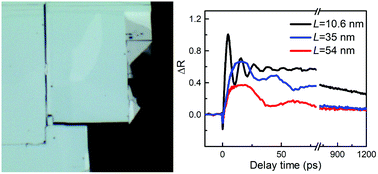
Phys. Chem. Chem. Phys., 2021,23, 20666-20674
https://doi.org/10.1039/D1CP03202J
Covalent photofunctionalization and electronic repair of 2H-MoS2via nitrogen incorporation
Ab initio calculations are used to study defect-free attachment of functional molecules via nitrogen incorporation at sulfur vacancies. This approach allows for stable modification while keeping the extraordinary properties of MoS2 monolayers.
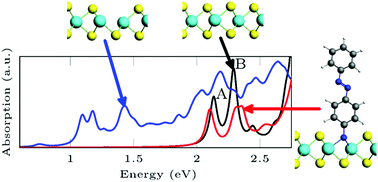
Phys. Chem. Chem. Phys., 2021,23, 18517-18524
https://doi.org/10.1039/D1CP02313F
Gate-tunable superconductivity and charge-density wave in monolayer 1T′-MoTe2 and 1T′-WTe2
Coexistence of topological insulating and charge density wave states are predicted in single-layered 1T′-MoTe2 and 1T′-WTe2 under gate doping.
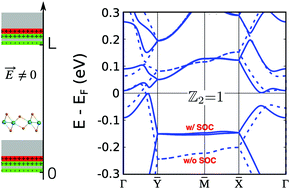
Phys. Chem. Chem. Phys., 2021,23, 17279-17286
https://doi.org/10.1039/D1CP02214H
Reversible photoluminescence modulation of monolayer MoS2 on a ferroelectric substrate by light irradiation and thermal annealing
Light irradiation and thermal annealing produced reversible surface charge distribution in Fe:LiNbO3 and hence reversibly modulated the optical properties of the supporting monolayer MoS2.
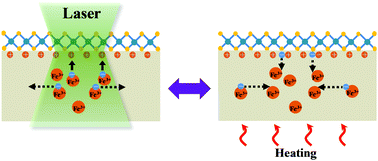
Phys. Chem. Chem. Phys., 2021,23, 17265-17270
https://doi.org/10.1039/D1CP02248B
Selection rule for Raman spectra of two-dimensional materials using circularly-polarized vortex light
Conservation of spin and orbital angular momenta of circularly-polarized vortex light is discussed for Raman spectra of two-dimensional materials.
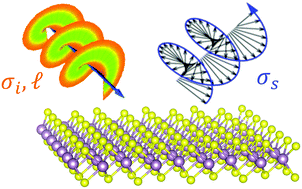
Phys. Chem. Chem. Phys., 2021,23, 17271-17278
https://doi.org/10.1039/D1CP02209A
Transient absorption measurements of interlayer charge transfer in a WS2/GeS van der Waals heterostructure
Differential reflection signal from WS2 monolayer (left) and WS2/GeS heterostructure (right) is measured. The shorter decay of the signal from heterostructure than that from WS2 ML provides convincing evidence of charge transfer between WS2 and GeS.

Phys. Chem. Chem. Phys., 2021,23, 17259-17264
https://doi.org/10.1039/D1CP01892B
Charge-transfer dynamics in van der Waals heterojunctions formed by thiophene-based semiconductor polymers and exfoliated franckeite investigated from resonantly core-excited electrons
We found evidence of ultrafast (subfemtosecond charge transfer times) interfacial electron delocalization pathways from specific electronic states.
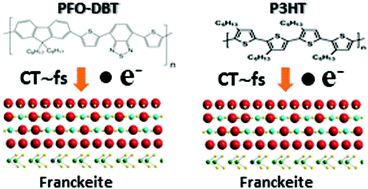
Phys. Chem. Chem. Phys., 2021,23, 16795-16805
https://doi.org/10.1039/D1CP01694F
About this collection
2D materials with atomic scale thinness have emerged as a new form of nanomaterial. While graphene was the focus of early studies, since 2010 hundreds of other types of 2D materials have been investigated. This includes elemental 2D materials such as phosphorene, borophene, silicene and antimonene, as well as compound materials such as transition metal chalcogenides and oxides, hexagonal boron nitride, MXenes, and organic-inorganic metal halide layered perovskites. The large number of materials and the many different ways they can be combined to form heterostructures offer a great opportunity to transform materials science and technology, and benefit society.
The goal of this themed collection is to highlight the latest developments in this exciting field. The collection welcomes new insights into 2D materials from theoretical, computational, and experimental communities. This collection will cover topics including, but not limited to, physical and chemical properties of 2D materials, synthesis techniques, structural characterization, 2D and mixed-dimensional heterostructures, functionalization of 2D materials, flexible 2D devices, new novel 2D materials, and applications of 2D materials in biological systems, chemical sensing, and energy technologies.